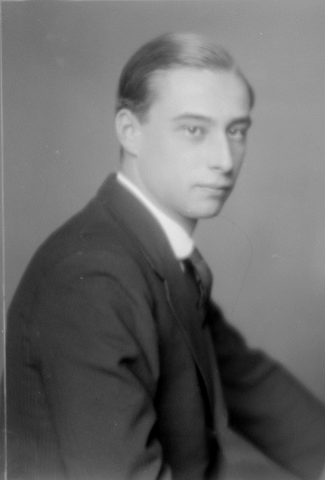Jaromir Czernin was a member of the Bohemian noble family Czernin von und zu Chudenitz. The end of the monarchy meant great cuts for his family: the title of nobility was abolished and a law on land reform was passed. The final step in the dissolution of the former noble dominions was the abolition of the entail estates in 1924. Johannes Vermeer's masterpiece Die Malkunst (The Art of Painting), in the family since 1804, belonged to the Czernin entail estate. In 1925, the question arose as to who should become the owner of the picture gallery stored in the palace at Friedrich Schmidt-Platz 4 in Vienna’s 8th district, Jaromir Czernin or his uncle Eugen Czernin. In 1933, the two agreed in a private-law settlement that Jaromir Czernin should receive the painting for the purpose of sale and pay 20% of the proceeds to Eugen Czernin, while Eugen Czernin should receive the remaining works in the gallery. However, until 1938, the implementation of this agreement failed due to the resistance of the Federal Monuments Office, which opposed the export permit required for a sale of Die Malkunst outside the country.
After the annexation of Austria to the German Reich, the sales market for which no export permit was required expanded. In May 1938, Jaromir Czernin married his second wife Alix May, née Frankenberg-Ludwigsdorf, divorced Zandt, divorced Faber-Castell. On 9 April 1940, Jaromir Czernin applied for membership in the NSDAP at the local group Marschendorf 2, Gau Sudetenland. District leader Johann Hofhansel and mayor Franz Kasper rejected the application because of the “baseless character of the applicant”. Finally, Jaromir Czernin sold Die Malkunst in October 1940 for RM 1,650,000 to Adolf Hitler, who had the painting moved to the Munich "Führerbau". In the divorce proceedings in 1942, Czernin accused his wife of claiming before the marriage that she was "only 1/8 Jewish", while he had only learned afterwards that she was considered a "second degree Mischling" under the Nuremberg Laws because of a Jewish grandparent. In April 1943, Jaromir Czernin moved to Altaussee, which he was to justify after the end of the war with the fact that "at the end of 1942/beginning of 1943" he had been forbidden to manage his castle in Marschendorf, including his inherited forestry business, as well as to stay in the entire Sudetengau. In fact, however, the reason for the change of residence may have been the economic difficulties in managing the business. On 27 November 1944, he remarried Alix May in Altaussee. He was ultimately divorced from Alix May again in 1951 and was to enter into two more marriages thereafter.
The Vermeer masterpiece, salvaged from the Altaussee salt mine in 1943/44, was transferred to the Central Collecting Point in Munich at the end of the war. In November 1945, the American military government handed the painting over to the Austrian government in Vienna, which had it transferred to the Kunsthistorisches Museum (KHM) for safekeeping. In October 1947, Jaromir Czernin applied for the restitution of the painting in accordance with the Third Restitution Act. The Restitution Commission rejected the application as unfounded in its decision of 11 January 1949. The Supreme Restitution Commission at the Supreme Court rejected the appeal on 14 May 1949, since neither a political persecution of Jaromir Czernin or his wife Alix Czernin nor a resulting forced sale could be proven. A lawsuit filed in 1950 by Jaromir Czernin against the Republic of Austria at the Landesgericht für Zivilrechtssachen Wien (Provincial Court for Civil Matters Vienna) was dismissed on the grounds of the inadmissibility of the legal proceedings in all three instances. The decision of the People's Court of 31 March 1952, meanwhile, declared Adolf Hitler's assets, consisting of his paintings, to have been forfeited to the Federation in accordance with the 1947 Law on the Forfeiture of Assets. In February 1953, Jaromir Czernin brought claims for restitution under the Second Restitution Act, as the painting had in the meantime become the property of the Republic of Austria, which the Financial Directorate rejected with reference to previous decisions. The appeal filed against this decision was initially granted by the Federal Minister of Finance in his decision of 26 August 1955, but was ultimately dismissed because he came to the conclusion that the sale was not to be assessed as a seizure. At the end of 1958/beginning of 1959, Die Malkunst was included in the inventory of the KHM's Picture Gallery. In 2009, descendants of Jaromir Czernin publicly demanded the return of the valuable painting. The Art Restitution Advisory Board, which dealt with the case at its meeting on 18 March 2011, also did not recommend the return of the painting.

